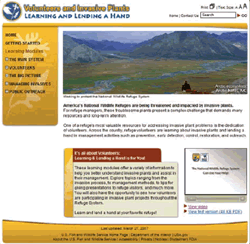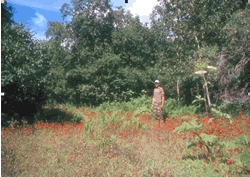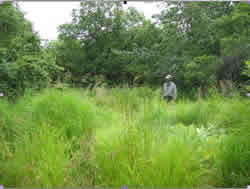 |
| |
Volunteers and Invasives: Learning and Lending a Hand is the Refuge System’s first online, self-study course helped train Refuge Friends and volunteers to fight invasive species. It includes a thorough but simplified explanation of Integrated Pest Management, among other elements.
|
Integrated Pest Management (IPM) is a
comprehensive, environmentally sensitive approach to managing pests that
includes a combination of strategies that pose the least
hazard to people, property,
and the environment. The simple philosophy
is that control will be more effective, and
resistance
will be less likely to build up, when a range of measures
is deployed
against a pest. These measures can include, cultural, mechanical
or physical, biological,
and chemical methods
for managing the pest.
Some of the key components
to a successful IPM program include the following:
 |
Orange
hawkweed infestation,
Kodiak National Wildlife Refuge, Camp Island, Alaska |
 |
| Same
location after three years treatment with herbicide. |
The pest issues affecting Service trust resources are broad
and complex. The competition and predation of nonnative species
poses risks to approximately 50% of threatened and endangered
species. Some of the top pest issues
affecting Service trust resources include the Norway rat, arctic
fox, northern pike, European starling, European green crab,
Chinese
mitten
crab,
Canada
and musk thistle, purple loosestrife, saltcedar (tamarisk),
Chinese tallow tree, Russian knapweed, spotted knapweed,
buffel grass, ox-eye daisy, orange hawkweed, Johnson grass,
field bindweed, leafy spurge, Russian olive, Dalmatian and
yellow toadflax, salvinia molesta, and soybean aphid.
 Pest:
Any living organism (plant or animal) that occurs
where it is not wanted or that causes damage to crops or
humans or other animals. Pest:
Any living organism (plant or animal) that occurs
where it is not wanted or that causes damage to crops or
humans or other animals.
 Cultural management: Cultural
practices are a manipulation of the habitat environment to
increase pest mortality or reduce rates of pest increase
and damage. There are many different cultural practices that
can help to reduce pest impact such as selection of pest
resistant varieties of crops, mulching, winter cover crops,
changing planting dates to minimize insect impact, burning,
flooding, crop rotations that include non-susceptible crops,
moisture management, addition of beneficial insect habitat,
or other habitat alterations. Cultural management: Cultural
practices are a manipulation of the habitat environment to
increase pest mortality or reduce rates of pest increase
and damage. There are many different cultural practices that
can help to reduce pest impact such as selection of pest
resistant varieties of crops, mulching, winter cover crops,
changing planting dates to minimize insect impact, burning,
flooding, crop rotations that include non-susceptible crops,
moisture management, addition of beneficial insect habitat,
or other habitat alterations.
 Mechanical
or Physical Management: Mechanical
or physical control methods involve using barriers, traps,
or physical removal to prevent or reduce pest problems.
Tactics may include using row covers or trenches to prevent
insects from reaching the crop, baited or pheromone
traps to capture insects, or cultivation or mowing for
weed control. Mechanical
or Physical Management: Mechanical
or physical control methods involve using barriers, traps,
or physical removal to prevent or reduce pest problems.
Tactics may include using row covers or trenches to prevent
insects from reaching the crop, baited or pheromone
traps to capture insects, or cultivation or mowing for
weed control.
 Biological
Management: Biological control
is the deliberate use of the pest's natural enemies - predators,
parasites,
and
pathogens
- to reduce the pest population below damage levels. Biological
Management: Biological control
is the deliberate use of the pest's natural enemies - predators,
parasites,
and
pathogens
- to reduce the pest population below damage levels.
 Chemical Control: When
exploring chemical control options, you should select the
lowest risk and most effective products. The key is to
use pesticides in a way that complements rather than hinders
other elements in the strategy and which also limits negative
environmental effects. It is important to understand the life
cycle of a pest so that the pesticide can be applied when the
pest is at its most vulnerable – the aim is to achieve
maximum effect at minimum levels of pesticide. Chemical Control: When
exploring chemical control options, you should select the
lowest risk and most effective products. The key is to
use pesticides in a way that complements rather than hinders
other elements in the strategy and which also limits negative
environmental effects. It is important to understand the life
cycle of a pest so that the pesticide can be applied when the
pest is at its most vulnerable – the aim is to achieve
maximum effect at minimum levels of pesticide.
Additional Info.:
Reducing Risks to Pollinators from
Pest Management Activities (pdf). U.S.
Fish and Wildlife Service. October 2006.
Reducing the Risks from Pests and
Pest Management Activities (pdf). U.S.
Fish and Wildlife Service. July 2004.
Integrated Pest Management Policy (pdf). Department of the Interior.
Departmental Manual. (Effective Date: 5/31/07
Series: Environmental Quality Programs
Part 517: Pesticides).
Pest
Management Policy and Responsibilities (pdf). U.S.
Fish and Wildlife Service. (Environment
30 AM 12. Release 30-5, 8-22-90).
Pest Control (pdf). U.S.
Fish and Wildlife Service. Refuge Manual. (Populations
Management 7 RM 14. Release: 003 March 12, 1982).
U.S.
Fish and Wildlife Service, Map
with links to Regional and National IPM
Contacts.
Instructions
for Preparing Integrated Pest Management Plans (pdf) for
U.S. Fish and Wildlife Service Lands. 2004.
Other Department
of the Interior Agency Links:
National
Park Service, Integrated Pest Management - http://www.nature.nps.gov/biology/ipm/
Bureau of Reclamation, Ecological Research and Investigations:
Aquatic Site Pest Management - http://www.usbr.gov/pmts/eco_research/eco1.html
Other Links:
Bio-Integral Resource
Center (BIRC). Specializes in finding non-toxic and least-toxic,
integrated pest management (IPM) solutions
to urban and agricultural pest problems - http://www.birc.org/.
IPM Institute of North
America. An independent non-profit organization
whose
mission is to accelerate adoption of IPM in agriculture and
communities through
consumer education and development of IPM standards for self-evaluation
and IPM certification - http://www.ipminstitute.org/index.htm.
North Central IPM Center: National Road Map for Integrated Pest Management |
